Case Study on African Illness
VerifiedAdded on 2023/05/28
|8
|1987
|158
AI Summary
This essay discusses various pathogenic diseases, causative agents of African sleeping sickness, identifying tests for pathogenic diseases, their defense mechanism, immunity procedures, developing a drug for preventing them.
Contribute Materials
Your contribution can guide someone’s learning journey. Share your
documents today.
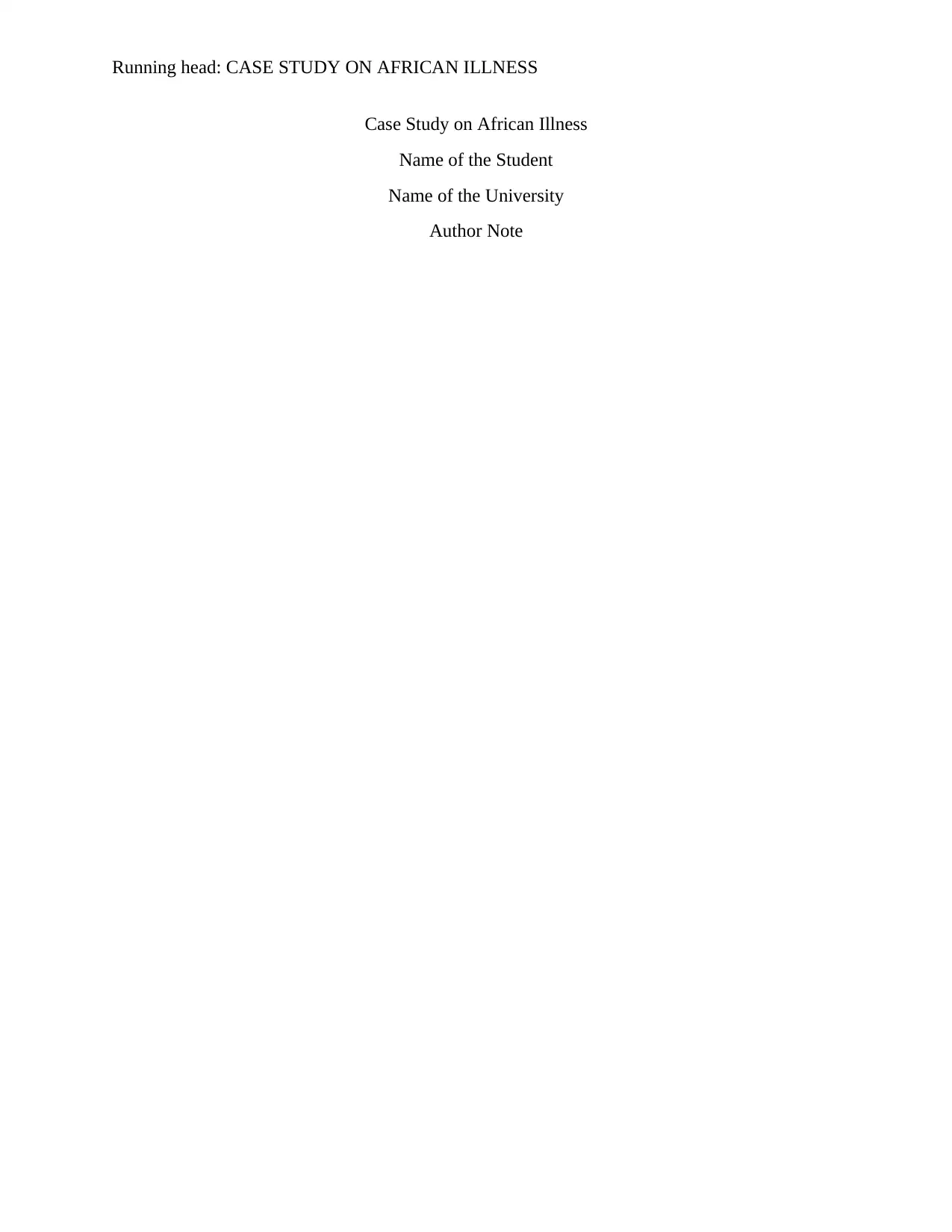
Running head: CASE STUDY ON AFRICAN ILLNESS
Case Study on African Illness
Name of the Student
Name of the University
Author Note
Case Study on African Illness
Name of the Student
Name of the University
Author Note
Secure Best Marks with AI Grader
Need help grading? Try our AI Grader for instant feedback on your assignments.
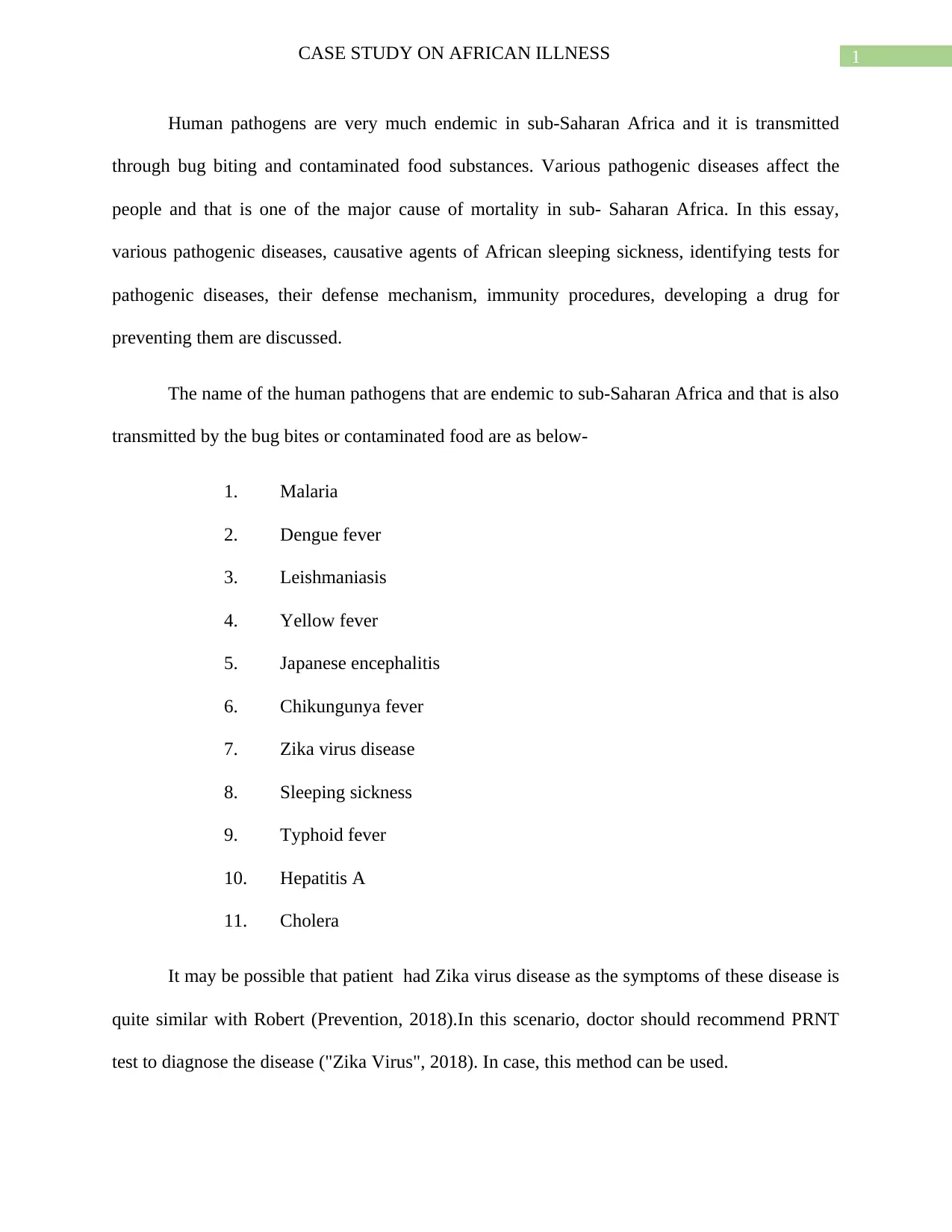
1CASE STUDY ON AFRICAN ILLNESS
Human pathogens are very much endemic in sub-Saharan Africa and it is transmitted
through bug biting and contaminated food substances. Various pathogenic diseases affect the
people and that is one of the major cause of mortality in sub- Saharan Africa. In this essay,
various pathogenic diseases, causative agents of African sleeping sickness, identifying tests for
pathogenic diseases, their defense mechanism, immunity procedures, developing a drug for
preventing them are discussed.
The name of the human pathogens that are endemic to sub-Saharan Africa and that is also
transmitted by the bug bites or contaminated food are as below-
1. Malaria
2. Dengue fever
3. Leishmaniasis
4. Yellow fever
5. Japanese encephalitis
6. Chikungunya fever
7. Zika virus disease
8. Sleeping sickness
9. Typhoid fever
10. Hepatitis A
11. Cholera
It may be possible that patient had Zika virus disease as the symptoms of these disease is
quite similar with Robert (Prevention, 2018).In this scenario, doctor should recommend PRNT
test to diagnose the disease ("Zika Virus", 2018). In case, this method can be used.
Human pathogens are very much endemic in sub-Saharan Africa and it is transmitted
through bug biting and contaminated food substances. Various pathogenic diseases affect the
people and that is one of the major cause of mortality in sub- Saharan Africa. In this essay,
various pathogenic diseases, causative agents of African sleeping sickness, identifying tests for
pathogenic diseases, their defense mechanism, immunity procedures, developing a drug for
preventing them are discussed.
The name of the human pathogens that are endemic to sub-Saharan Africa and that is also
transmitted by the bug bites or contaminated food are as below-
1. Malaria
2. Dengue fever
3. Leishmaniasis
4. Yellow fever
5. Japanese encephalitis
6. Chikungunya fever
7. Zika virus disease
8. Sleeping sickness
9. Typhoid fever
10. Hepatitis A
11. Cholera
It may be possible that patient had Zika virus disease as the symptoms of these disease is
quite similar with Robert (Prevention, 2018).In this scenario, doctor should recommend PRNT
test to diagnose the disease ("Zika Virus", 2018). In case, this method can be used.

2CASE STUDY ON AFRICAN ILLNESS
Protozoan are single celled heterotrophic eukaryotes which consume bacteria and other
various food resources. In addition to this, one of the major characteristics of protozoan is that it
can divide only inside a host organism. A bacteria does not have any nucleus, whereas a protozoa
have a nucleus. Protozoa is further developed form bacteria. In human body there is a huge
amount of good and bad bacteria. In case of protozoa, it is occasionally found in the human body
(Anwar & Gourinath, 2016). T.brucei is the causative agent of African sleeping sickness whereas
T.cruzi is responsible for the South American sleeping sickness. T.cruzi resides in the nervous
and muscular tissue of the vertebrates and humans. T.brucei mainly multiplies themselves inside
the connective tissues such as lymph, blood and finally transmitted to the brain. On the other
hand Plasmodium falciparum is responsible for the malaria disease. Some T.brucei may have
not flagella, but in case of falciparum, must have flagella. In short, stumpy and thick T.brucei
have the measure of 10 micrometer long and 5 micrometer broad. The long sender forms are
almost 20 micrometer long and 3 micrometer broad. The two main morphological form of
T.cruzi is amastigote form and the other one is trypomastigate form. The first one is 2-4
micrometer in diameter and the former one is 20 micrometer long and 6 micrometer broad.
Pentamidine is generally recommended for the first stage of the disease caused by T.brucei. In
case of T.cruzi, it is generally recommended to gastroenterologist, cardiologist (Jain, 2018).
There are two subspecies of T.brucei that are responsible for the African sleeping
sickness in the humans. However, the two different type of subspecies is generally found in two
different part of the Africa and there is no geographical overlap till now. The T.b.rhodesiense
that refers to the east African sleeping sickness and it is generally transmitted through various
animals. Generally cattle are responsible for the transmission of this disease. On the other hand
the T.b.gambiense is responsible for the West African sleeping sickness. In this case the humans
Protozoan are single celled heterotrophic eukaryotes which consume bacteria and other
various food resources. In addition to this, one of the major characteristics of protozoan is that it
can divide only inside a host organism. A bacteria does not have any nucleus, whereas a protozoa
have a nucleus. Protozoa is further developed form bacteria. In human body there is a huge
amount of good and bad bacteria. In case of protozoa, it is occasionally found in the human body
(Anwar & Gourinath, 2016). T.brucei is the causative agent of African sleeping sickness whereas
T.cruzi is responsible for the South American sleeping sickness. T.cruzi resides in the nervous
and muscular tissue of the vertebrates and humans. T.brucei mainly multiplies themselves inside
the connective tissues such as lymph, blood and finally transmitted to the brain. On the other
hand Plasmodium falciparum is responsible for the malaria disease. Some T.brucei may have
not flagella, but in case of falciparum, must have flagella. In short, stumpy and thick T.brucei
have the measure of 10 micrometer long and 5 micrometer broad. The long sender forms are
almost 20 micrometer long and 3 micrometer broad. The two main morphological form of
T.cruzi is amastigote form and the other one is trypomastigate form. The first one is 2-4
micrometer in diameter and the former one is 20 micrometer long and 6 micrometer broad.
Pentamidine is generally recommended for the first stage of the disease caused by T.brucei. In
case of T.cruzi, it is generally recommended to gastroenterologist, cardiologist (Jain, 2018).
There are two subspecies of T.brucei that are responsible for the African sleeping
sickness in the humans. However, the two different type of subspecies is generally found in two
different part of the Africa and there is no geographical overlap till now. The T.b.rhodesiense
that refers to the east African sleeping sickness and it is generally transmitted through various
animals. Generally cattle are responsible for the transmission of this disease. On the other hand
the T.b.gambiense is responsible for the West African sleeping sickness. In this case the humans
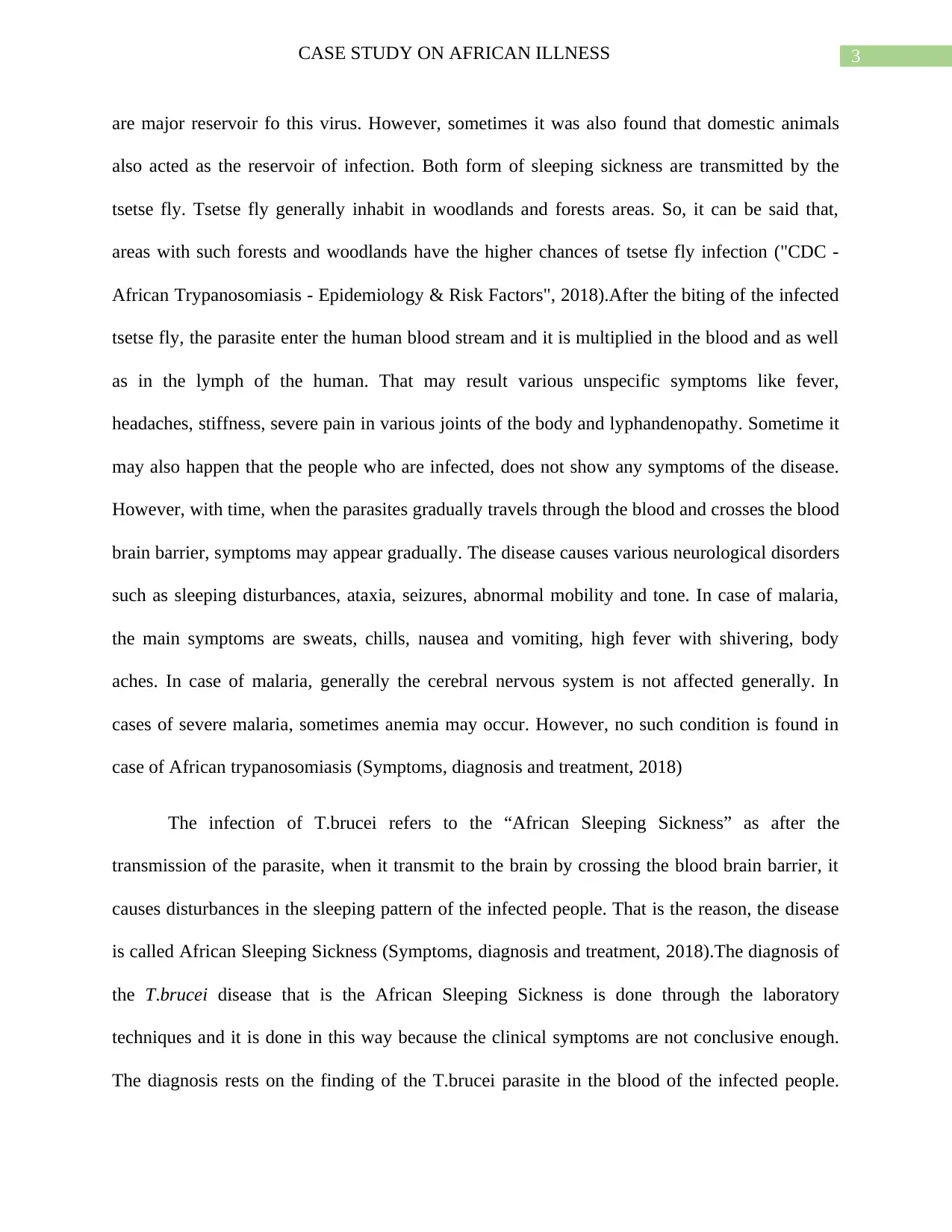
3CASE STUDY ON AFRICAN ILLNESS
are major reservoir fo this virus. However, sometimes it was also found that domestic animals
also acted as the reservoir of infection. Both form of sleeping sickness are transmitted by the
tsetse fly. Tsetse fly generally inhabit in woodlands and forests areas. So, it can be said that,
areas with such forests and woodlands have the higher chances of tsetse fly infection ("CDC -
African Trypanosomiasis - Epidemiology & Risk Factors", 2018).After the biting of the infected
tsetse fly, the parasite enter the human blood stream and it is multiplied in the blood and as well
as in the lymph of the human. That may result various unspecific symptoms like fever,
headaches, stiffness, severe pain in various joints of the body and lyphandenopathy. Sometime it
may also happen that the people who are infected, does not show any symptoms of the disease.
However, with time, when the parasites gradually travels through the blood and crosses the blood
brain barrier, symptoms may appear gradually. The disease causes various neurological disorders
such as sleeping disturbances, ataxia, seizures, abnormal mobility and tone. In case of malaria,
the main symptoms are sweats, chills, nausea and vomiting, high fever with shivering, body
aches. In case of malaria, generally the cerebral nervous system is not affected generally. In
cases of severe malaria, sometimes anemia may occur. However, no such condition is found in
case of African trypanosomiasis (Symptoms, diagnosis and treatment, 2018)
The infection of T.brucei refers to the “African Sleeping Sickness” as after the
transmission of the parasite, when it transmit to the brain by crossing the blood brain barrier, it
causes disturbances in the sleeping pattern of the infected people. That is the reason, the disease
is called African Sleeping Sickness (Symptoms, diagnosis and treatment, 2018).The diagnosis of
the T.brucei disease that is the African Sleeping Sickness is done through the laboratory
techniques and it is done in this way because the clinical symptoms are not conclusive enough.
The diagnosis rests on the finding of the T.brucei parasite in the blood of the infected people.
are major reservoir fo this virus. However, sometimes it was also found that domestic animals
also acted as the reservoir of infection. Both form of sleeping sickness are transmitted by the
tsetse fly. Tsetse fly generally inhabit in woodlands and forests areas. So, it can be said that,
areas with such forests and woodlands have the higher chances of tsetse fly infection ("CDC -
African Trypanosomiasis - Epidemiology & Risk Factors", 2018).After the biting of the infected
tsetse fly, the parasite enter the human blood stream and it is multiplied in the blood and as well
as in the lymph of the human. That may result various unspecific symptoms like fever,
headaches, stiffness, severe pain in various joints of the body and lyphandenopathy. Sometime it
may also happen that the people who are infected, does not show any symptoms of the disease.
However, with time, when the parasites gradually travels through the blood and crosses the blood
brain barrier, symptoms may appear gradually. The disease causes various neurological disorders
such as sleeping disturbances, ataxia, seizures, abnormal mobility and tone. In case of malaria,
the main symptoms are sweats, chills, nausea and vomiting, high fever with shivering, body
aches. In case of malaria, generally the cerebral nervous system is not affected generally. In
cases of severe malaria, sometimes anemia may occur. However, no such condition is found in
case of African trypanosomiasis (Symptoms, diagnosis and treatment, 2018)
The infection of T.brucei refers to the “African Sleeping Sickness” as after the
transmission of the parasite, when it transmit to the brain by crossing the blood brain barrier, it
causes disturbances in the sleeping pattern of the infected people. That is the reason, the disease
is called African Sleeping Sickness (Symptoms, diagnosis and treatment, 2018).The diagnosis of
the T.brucei disease that is the African Sleeping Sickness is done through the laboratory
techniques and it is done in this way because the clinical symptoms are not conclusive enough.
The diagnosis rests on the finding of the T.brucei parasite in the blood of the infected people.
Secure Best Marks with AI Grader
Need help grading? Try our AI Grader for instant feedback on your assignments.
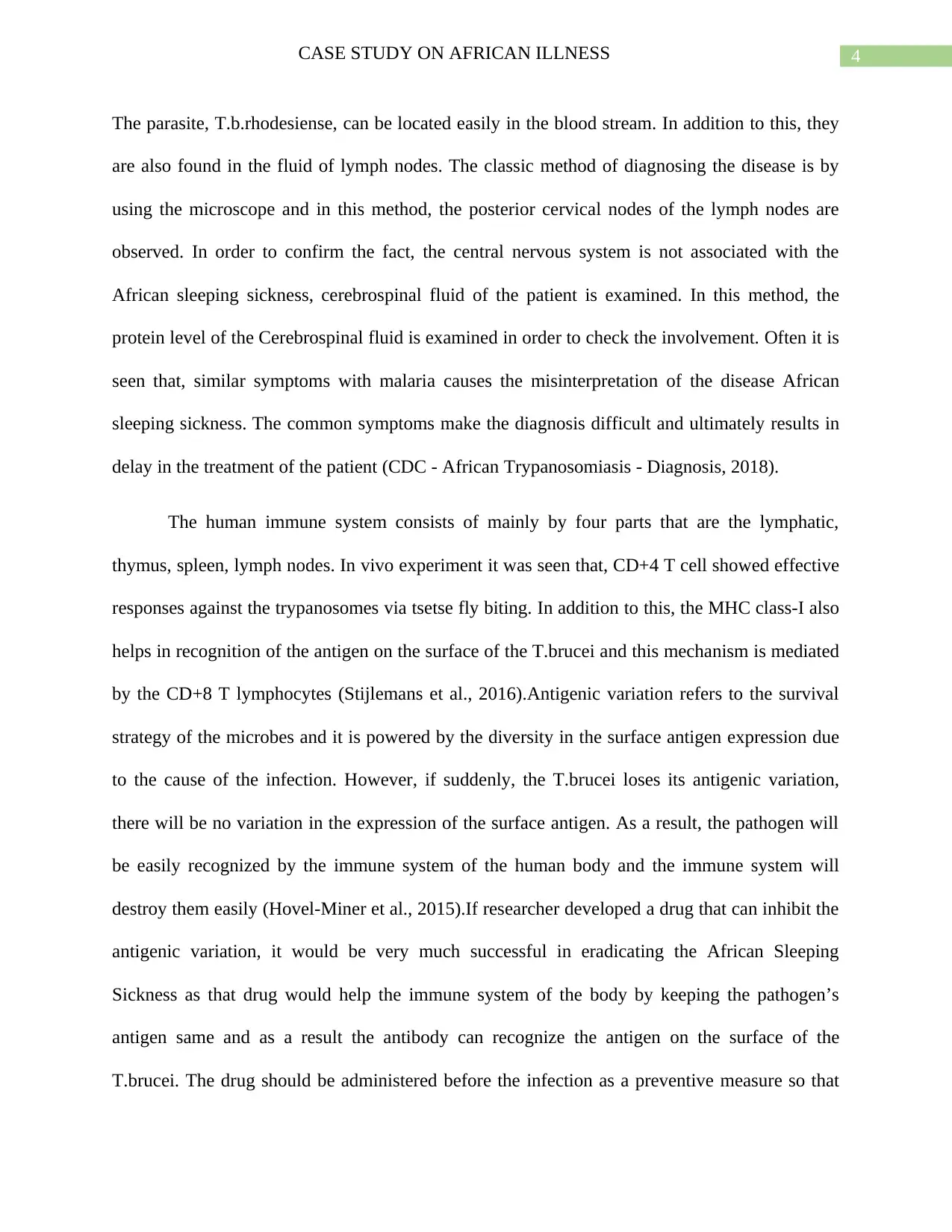
4CASE STUDY ON AFRICAN ILLNESS
The parasite, T.b.rhodesiense, can be located easily in the blood stream. In addition to this, they
are also found in the fluid of lymph nodes. The classic method of diagnosing the disease is by
using the microscope and in this method, the posterior cervical nodes of the lymph nodes are
observed. In order to confirm the fact, the central nervous system is not associated with the
African sleeping sickness, cerebrospinal fluid of the patient is examined. In this method, the
protein level of the Cerebrospinal fluid is examined in order to check the involvement. Often it is
seen that, similar symptoms with malaria causes the misinterpretation of the disease African
sleeping sickness. The common symptoms make the diagnosis difficult and ultimately results in
delay in the treatment of the patient (CDC - African Trypanosomiasis - Diagnosis, 2018).
The human immune system consists of mainly by four parts that are the lymphatic,
thymus, spleen, lymph nodes. In vivo experiment it was seen that, CD+4 T cell showed effective
responses against the trypanosomes via tsetse fly biting. In addition to this, the MHC class-I also
helps in recognition of the antigen on the surface of the T.brucei and this mechanism is mediated
by the CD+8 T lymphocytes (Stijlemans et al., 2016).Antigenic variation refers to the survival
strategy of the microbes and it is powered by the diversity in the surface antigen expression due
to the cause of the infection. However, if suddenly, the T.brucei loses its antigenic variation,
there will be no variation in the expression of the surface antigen. As a result, the pathogen will
be easily recognized by the immune system of the human body and the immune system will
destroy them easily (Hovel-Miner et al., 2015).If researcher developed a drug that can inhibit the
antigenic variation, it would be very much successful in eradicating the African Sleeping
Sickness as that drug would help the immune system of the body by keeping the pathogen’s
antigen same and as a result the antibody can recognize the antigen on the surface of the
T.brucei. The drug should be administered before the infection as a preventive measure so that
The parasite, T.b.rhodesiense, can be located easily in the blood stream. In addition to this, they
are also found in the fluid of lymph nodes. The classic method of diagnosing the disease is by
using the microscope and in this method, the posterior cervical nodes of the lymph nodes are
observed. In order to confirm the fact, the central nervous system is not associated with the
African sleeping sickness, cerebrospinal fluid of the patient is examined. In this method, the
protein level of the Cerebrospinal fluid is examined in order to check the involvement. Often it is
seen that, similar symptoms with malaria causes the misinterpretation of the disease African
sleeping sickness. The common symptoms make the diagnosis difficult and ultimately results in
delay in the treatment of the patient (CDC - African Trypanosomiasis - Diagnosis, 2018).
The human immune system consists of mainly by four parts that are the lymphatic,
thymus, spleen, lymph nodes. In vivo experiment it was seen that, CD+4 T cell showed effective
responses against the trypanosomes via tsetse fly biting. In addition to this, the MHC class-I also
helps in recognition of the antigen on the surface of the T.brucei and this mechanism is mediated
by the CD+8 T lymphocytes (Stijlemans et al., 2016).Antigenic variation refers to the survival
strategy of the microbes and it is powered by the diversity in the surface antigen expression due
to the cause of the infection. However, if suddenly, the T.brucei loses its antigenic variation,
there will be no variation in the expression of the surface antigen. As a result, the pathogen will
be easily recognized by the immune system of the human body and the immune system will
destroy them easily (Hovel-Miner et al., 2015).If researcher developed a drug that can inhibit the
antigenic variation, it would be very much successful in eradicating the African Sleeping
Sickness as that drug would help the immune system of the body by keeping the pathogen’s
antigen same and as a result the antibody can recognize the antigen on the surface of the
T.brucei. The drug should be administered before the infection as a preventive measure so that
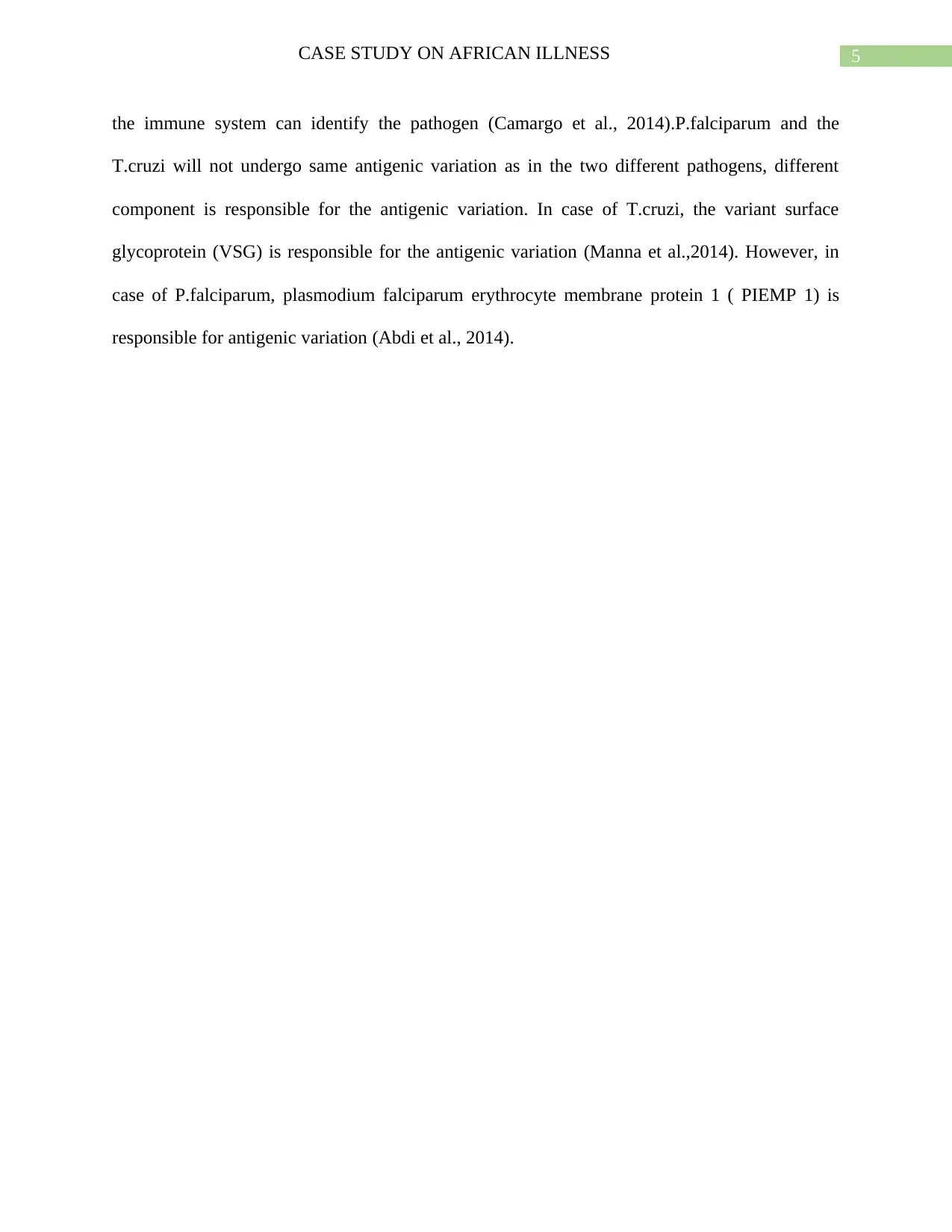
5CASE STUDY ON AFRICAN ILLNESS
the immune system can identify the pathogen (Camargo et al., 2014).P.falciparum and the
T.cruzi will not undergo same antigenic variation as in the two different pathogens, different
component is responsible for the antigenic variation. In case of T.cruzi, the variant surface
glycoprotein (VSG) is responsible for the antigenic variation (Manna et al.,2014). However, in
case of P.falciparum, plasmodium falciparum erythrocyte membrane protein 1 ( PIEMP 1) is
responsible for antigenic variation (Abdi et al., 2014).
the immune system can identify the pathogen (Camargo et al., 2014).P.falciparum and the
T.cruzi will not undergo same antigenic variation as in the two different pathogens, different
component is responsible for the antigenic variation. In case of T.cruzi, the variant surface
glycoprotein (VSG) is responsible for the antigenic variation (Manna et al.,2014). However, in
case of P.falciparum, plasmodium falciparum erythrocyte membrane protein 1 ( PIEMP 1) is
responsible for antigenic variation (Abdi et al., 2014).
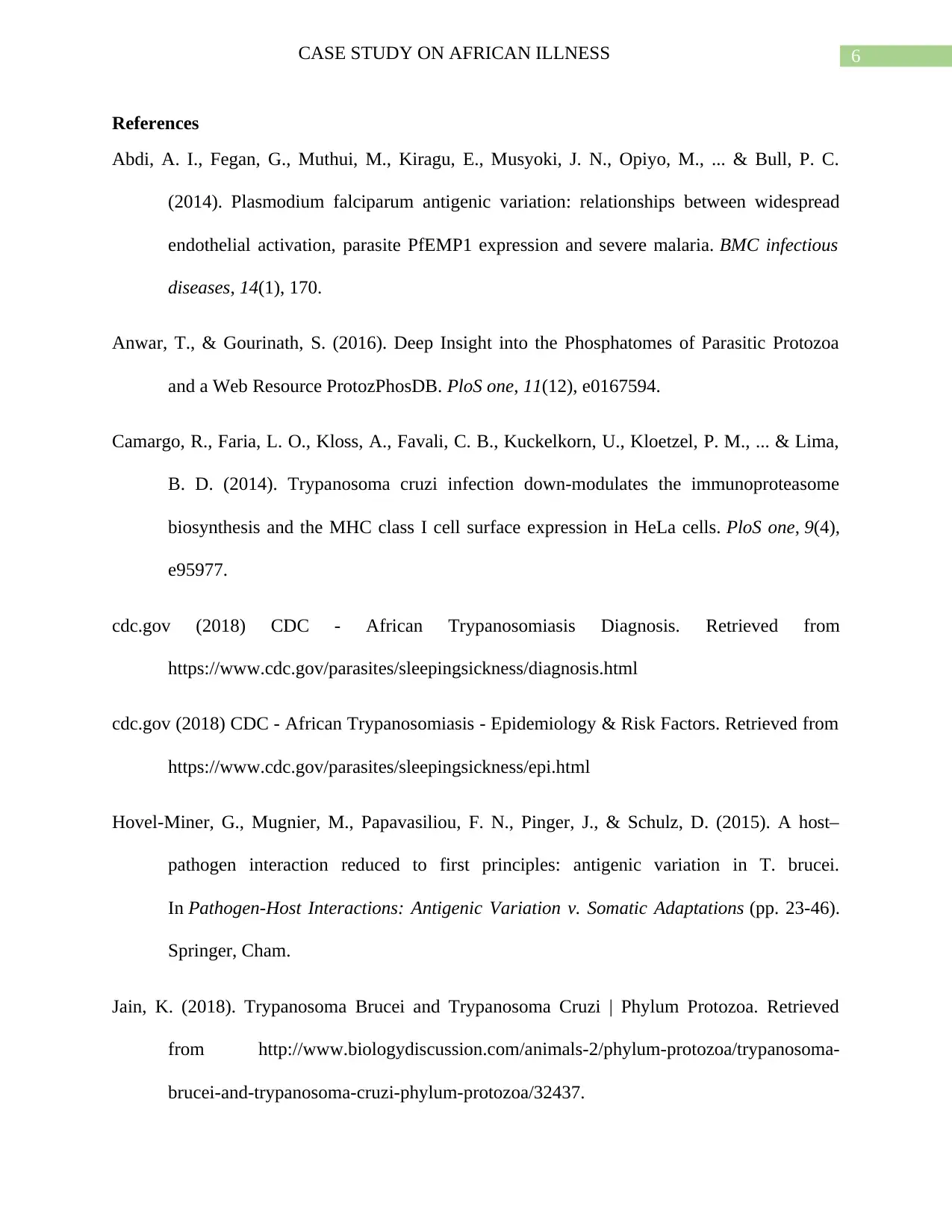
6CASE STUDY ON AFRICAN ILLNESS
References
Abdi, A. I., Fegan, G., Muthui, M., Kiragu, E., Musyoki, J. N., Opiyo, M., ... & Bull, P. C.
(2014). Plasmodium falciparum antigenic variation: relationships between widespread
endothelial activation, parasite PfEMP1 expression and severe malaria. BMC infectious
diseases, 14(1), 170.
Anwar, T., & Gourinath, S. (2016). Deep Insight into the Phosphatomes of Parasitic Protozoa
and a Web Resource ProtozPhosDB. PloS one, 11(12), e0167594.
Camargo, R., Faria, L. O., Kloss, A., Favali, C. B., Kuckelkorn, U., Kloetzel, P. M., ... & Lima,
B. D. (2014). Trypanosoma cruzi infection down-modulates the immunoproteasome
biosynthesis and the MHC class I cell surface expression in HeLa cells. PloS one, 9(4),
e95977.
cdc.gov (2018) CDC - African Trypanosomiasis Diagnosis. Retrieved from
https://www.cdc.gov/parasites/sleepingsickness/diagnosis.html
cdc.gov (2018) CDC - African Trypanosomiasis - Epidemiology & Risk Factors. Retrieved from
https://www.cdc.gov/parasites/sleepingsickness/epi.html
Hovel-Miner, G., Mugnier, M., Papavasiliou, F. N., Pinger, J., & Schulz, D. (2015). A host–
pathogen interaction reduced to first principles: antigenic variation in T. brucei.
In Pathogen-Host Interactions: Antigenic Variation v. Somatic Adaptations (pp. 23-46).
Springer, Cham.
Jain, K. (2018). Trypanosoma Brucei and Trypanosoma Cruzi | Phylum Protozoa. Retrieved
from http://www.biologydiscussion.com/animals-2/phylum-protozoa/trypanosoma-
brucei-and-trypanosoma-cruzi-phylum-protozoa/32437.
References
Abdi, A. I., Fegan, G., Muthui, M., Kiragu, E., Musyoki, J. N., Opiyo, M., ... & Bull, P. C.
(2014). Plasmodium falciparum antigenic variation: relationships between widespread
endothelial activation, parasite PfEMP1 expression and severe malaria. BMC infectious
diseases, 14(1), 170.
Anwar, T., & Gourinath, S. (2016). Deep Insight into the Phosphatomes of Parasitic Protozoa
and a Web Resource ProtozPhosDB. PloS one, 11(12), e0167594.
Camargo, R., Faria, L. O., Kloss, A., Favali, C. B., Kuckelkorn, U., Kloetzel, P. M., ... & Lima,
B. D. (2014). Trypanosoma cruzi infection down-modulates the immunoproteasome
biosynthesis and the MHC class I cell surface expression in HeLa cells. PloS one, 9(4),
e95977.
cdc.gov (2018) CDC - African Trypanosomiasis Diagnosis. Retrieved from
https://www.cdc.gov/parasites/sleepingsickness/diagnosis.html
cdc.gov (2018) CDC - African Trypanosomiasis - Epidemiology & Risk Factors. Retrieved from
https://www.cdc.gov/parasites/sleepingsickness/epi.html
Hovel-Miner, G., Mugnier, M., Papavasiliou, F. N., Pinger, J., & Schulz, D. (2015). A host–
pathogen interaction reduced to first principles: antigenic variation in T. brucei.
In Pathogen-Host Interactions: Antigenic Variation v. Somatic Adaptations (pp. 23-46).
Springer, Cham.
Jain, K. (2018). Trypanosoma Brucei and Trypanosoma Cruzi | Phylum Protozoa. Retrieved
from http://www.biologydiscussion.com/animals-2/phylum-protozoa/trypanosoma-
brucei-and-trypanosoma-cruzi-phylum-protozoa/32437.
Paraphrase This Document
Need a fresh take? Get an instant paraphrase of this document with our AI Paraphraser
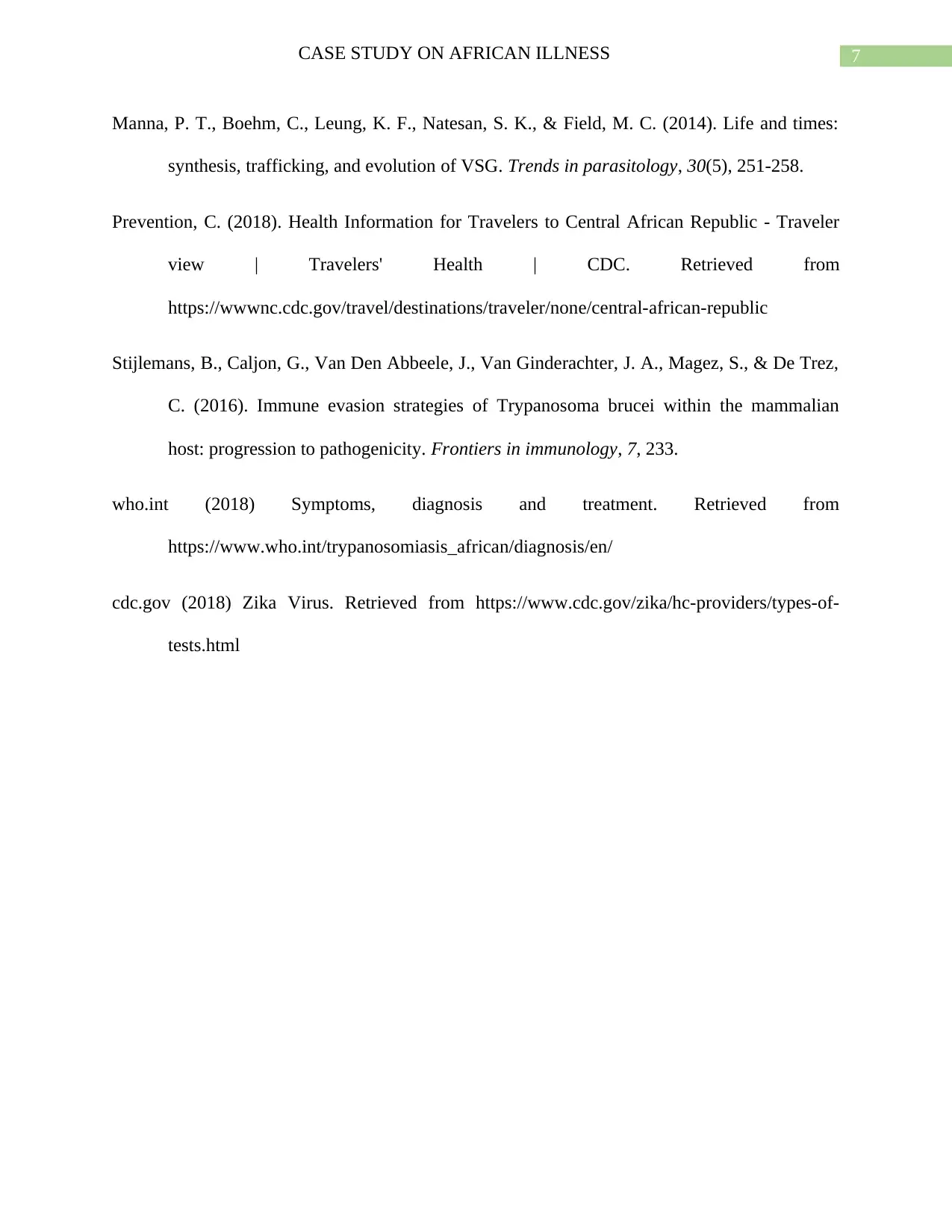
7CASE STUDY ON AFRICAN ILLNESS
Manna, P. T., Boehm, C., Leung, K. F., Natesan, S. K., & Field, M. C. (2014). Life and times:
synthesis, trafficking, and evolution of VSG. Trends in parasitology, 30(5), 251-258.
Prevention, C. (2018). Health Information for Travelers to Central African Republic - Traveler
view | Travelers' Health | CDC. Retrieved from
https://wwwnc.cdc.gov/travel/destinations/traveler/none/central-african-republic
Stijlemans, B., Caljon, G., Van Den Abbeele, J., Van Ginderachter, J. A., Magez, S., & De Trez,
C. (2016). Immune evasion strategies of Trypanosoma brucei within the mammalian
host: progression to pathogenicity. Frontiers in immunology, 7, 233.
who.int (2018) Symptoms, diagnosis and treatment. Retrieved from
https://www.who.int/trypanosomiasis_african/diagnosis/en/
cdc.gov (2018) Zika Virus. Retrieved from https://www.cdc.gov/zika/hc-providers/types-of-
tests.html
Manna, P. T., Boehm, C., Leung, K. F., Natesan, S. K., & Field, M. C. (2014). Life and times:
synthesis, trafficking, and evolution of VSG. Trends in parasitology, 30(5), 251-258.
Prevention, C. (2018). Health Information for Travelers to Central African Republic - Traveler
view | Travelers' Health | CDC. Retrieved from
https://wwwnc.cdc.gov/travel/destinations/traveler/none/central-african-republic
Stijlemans, B., Caljon, G., Van Den Abbeele, J., Van Ginderachter, J. A., Magez, S., & De Trez,
C. (2016). Immune evasion strategies of Trypanosoma brucei within the mammalian
host: progression to pathogenicity. Frontiers in immunology, 7, 233.
who.int (2018) Symptoms, diagnosis and treatment. Retrieved from
https://www.who.int/trypanosomiasis_african/diagnosis/en/
cdc.gov (2018) Zika Virus. Retrieved from https://www.cdc.gov/zika/hc-providers/types-of-
tests.html
1 out of 8
Your All-in-One AI-Powered Toolkit for Academic Success.
+13062052269
info@desklib.com
Available 24*7 on WhatsApp / Email
![[object Object]](/_next/static/media/star-bottom.7253800d.svg)
Unlock your academic potential
© 2024 | Zucol Services PVT LTD | All rights reserved.


